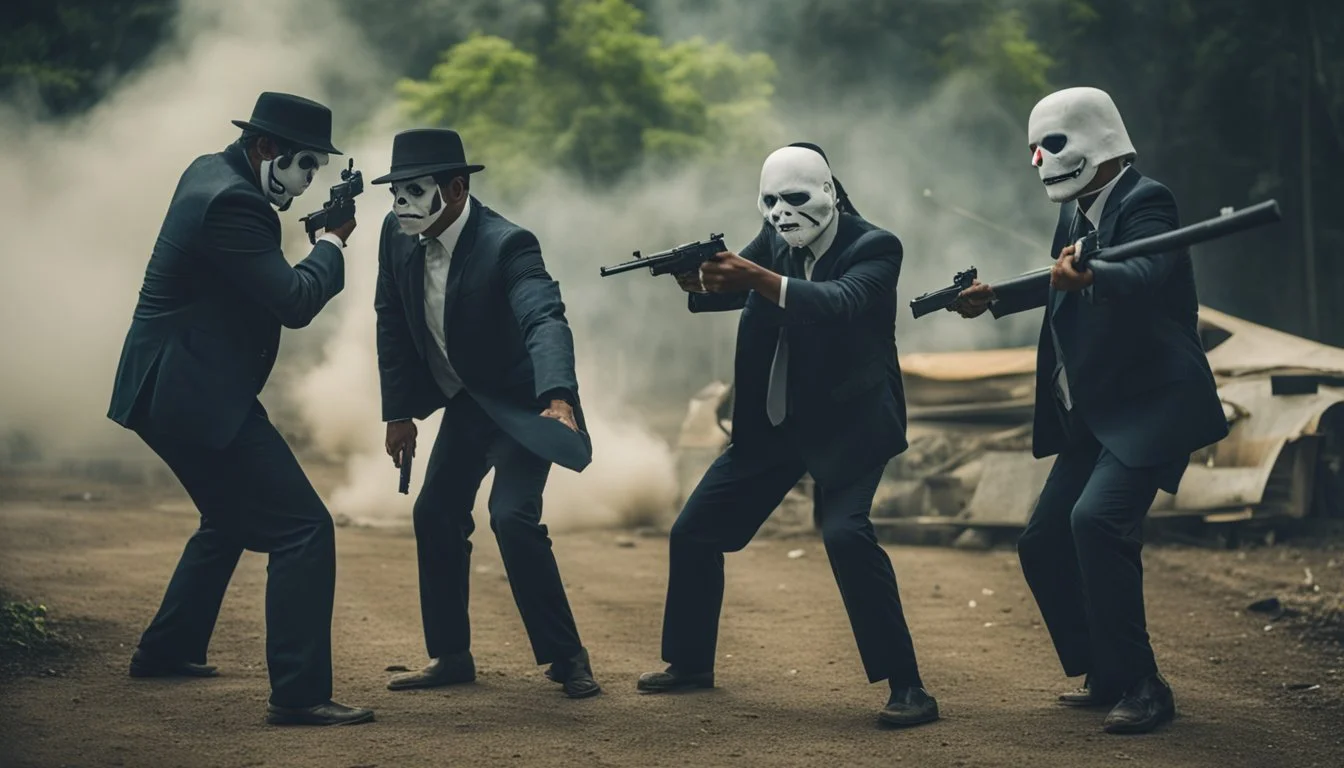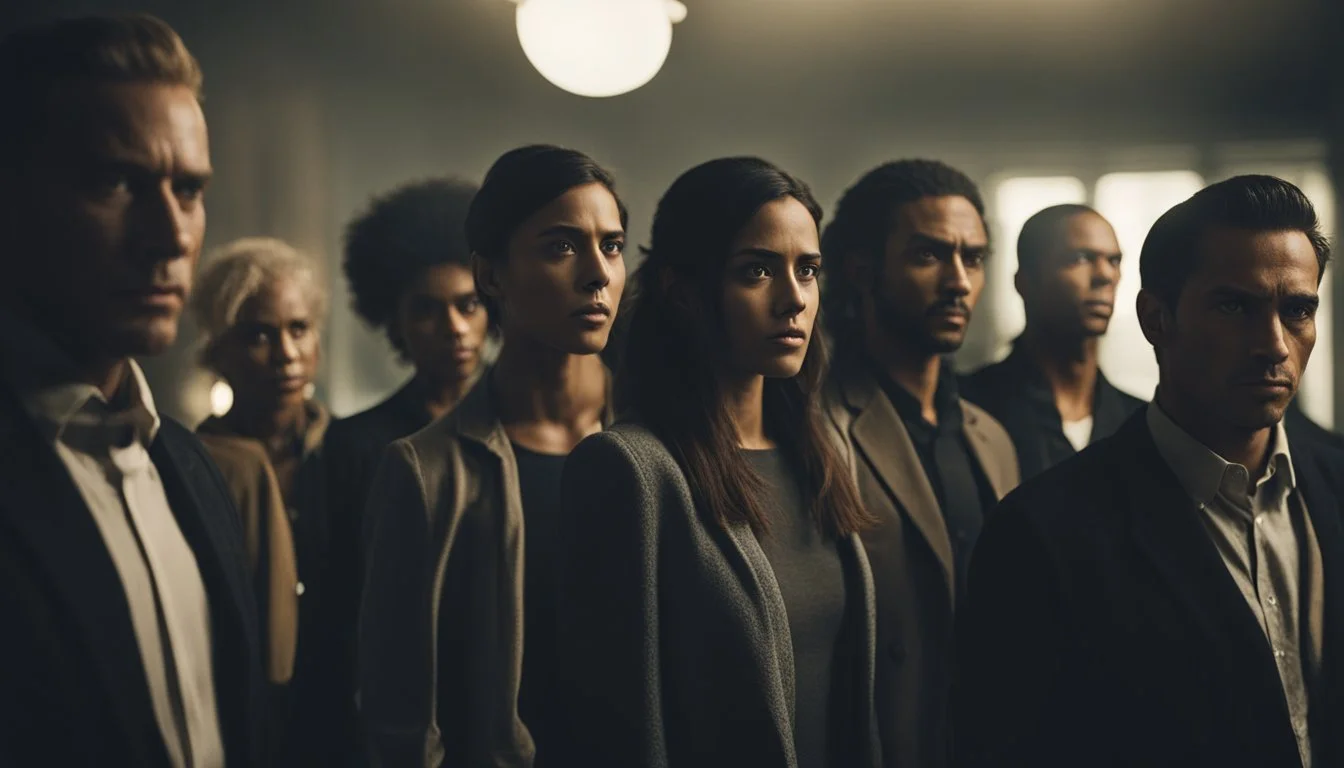The Act of Killing Documentary Pushes Ethical Boundaries by Reenacting Crimes with Perpetrators
The documentary "The Act of Killing" confronts viewers with a chilling moral dilemma. Director Joshua Oppenheimer invites Indonesian death squad leaders who participated in mass killings during the 1960s to reenact their crimes on camera. This unconventional approach raises questions about the ethics of asking perpetrators to dramatize past atrocities.
By allowing these men to craft their own cinematic recreations, the film provides a window into how they perceive and justify their actions decades later. The gangsters initially embrace the opportunity, portraying themselves as heroic figures. Yet as they delve deeper into their memories, cracks begin to appear in their bravado.
Through this process, the documentary examines complex issues of trauma, memory, and accountability in post-genocide societies. It challenges viewers to confront uncomfortable truths about human nature and the lingering impacts of mass violence. The film's innovative techniques spark debate about the role of art in addressing historical atrocities and the limits of empathy.
Background of 'The Act of Killing'
'The Act of Killing' explores Indonesia's dark past through a controversial lens. The documentary confronts perpetrators of mass violence, inviting them to reenact their crimes on camera.
Overview of the Documentary
'The Act of Killing' is a groundbreaking 2012 documentary directed by Joshua Oppenheimer. The film focuses on the Indonesian genocides of 1965-66, where an estimated 500,000 to 1 million people were killed.
Oppenheimer takes an unconventional approach by asking former death squad leaders to recreate their acts of violence. This method provides a chilling glimpse into the minds of the perpetrators.
The documentary features Anwar Congo, a gangster who became a prominent death squad leader. Congo and his associates openly discuss their roles in the killings, often with unsettling pride.
Indonesia's Historical Context
The 1965-66 Indonesian massacres occurred during a period of political turmoil. Following an attempted coup, the military launched a brutal anti-communist purge.
The violence targeted alleged communists, ethnic Chinese, and other perceived enemies of the state. Many innocent civilians were caught in the crossfire.
This dark chapter in Indonesian history remained largely unaddressed for decades. The perpetrators faced no legal consequences and often held positions of power in society.
The government's official narrative downplayed the scale and brutality of the killings. This created a culture of impunity and selective memory.
Joshua Oppenheimer: The Visionary Behind the Film
Joshua Oppenheimer is an American-British film director known for his innovative approach to documentary filmmaking. He spent over a decade researching and working on projects related to the Indonesian genocide.
Oppenheimer's unique vision for 'The Act of Killing' came from his interactions with survivors and perpetrators. He realized that by allowing the killers to reenact their crimes, he could expose the psychology behind mass violence.
The director's approach was controversial but effective. It revealed the complex layers of denial, guilt, and justification that allowed the perpetrators to live with their actions.
Oppenheimer's work on 'The Act of Killing' earned him critical acclaim and numerous awards. The film sparked important conversations about historical memory and accountability.
Exploring the Moral Conundrums
Joshua Oppenheimer's documentary "The Act of Killing" presents complex ethical questions by having perpetrators reenact their crimes. This approach raises issues around culpability, desensitization to violence, and the nature of evil.
Representation of Evil and Guilt
The film challenges viewers' perceptions of evil by humanizing the killers. It shows them as ordinary people capable of horrific acts, echoing Hannah Arendt's concept of the "banality of evil." This representation forces audiences to confront uncomfortable truths about human nature.
The reenactments prompt some perpetrators to experience guilt or remorse for the first time. One killer, Anwar Congo, becomes physically ill when portraying a victim. This visceral reaction highlights the power of role reversal in eliciting emotional responses.
The documentary raises questions about collective guilt and societal complicity. By showcasing the killers' integration into everyday life, it implicates broader systems that allowed such atrocities to occur unchallenged.
Questioning the Glorification of Violence
"The Act of Killing" exposes how violence can be normalized and even celebrated within certain contexts. The perpetrators initially approach their reenactments with pride and bravado, revealing a disturbing glorification of their past actions.
This attitude reflects broader cultural narratives that often romanticize violence in media and entertainment. The film prompts viewers to critically examine their own consumption and acceptance of violent content.
By allowing the killers to create stylized, genre-inspired recreations, Oppenheimer highlights the dangerous intersection of fantasy and reality in justifying brutality. This approach forces audiences to confront their own potential for moral disengagement.
The Dilemma of Reenactments
The use of reenactments in "The Act of Killing" presents an ethical quandary. While it provides unique insights into the perpetrators' mindsets, it risks re-traumatizing victims and their families.
Critics argue that giving killers a platform to dramatize their crimes could be seen as exploitative or insensitive. However, supporters contend that this approach reveals truths that might otherwise remain hidden.
The reenactments blur the lines between documentary and fiction, raising questions about truth and representation in non-fiction filmmaking. This ambiguity challenges viewers to critically engage with the material and draw their own conclusions.
Portraits of Perpetrators and Victims
The Act of Killing presents complex portraits of those involved in Indonesia's 1965-66 mass killings, exploring the humanity and monstrosity in both perpetrators and victims.
Anwar Congo and Fellow Executioners
Anwar Congo emerges as the central figure among the former death squad leaders. Once a small-time gangster, he became an efficient killer during the purge. The film shows Congo proudly demonstrating his garroting technique.
Other executioners like Herman Koto join Congo in reenacting their crimes. They discuss their actions with disturbing nonchalance, even boasting about their methods.
The perpetrators' casual attitudes contrast sharply with moments of apparent remorse. Congo experiences nightmares and nausea when confronting his past. This duality highlights the psychological complexity of those who commit atrocities.
Contrasting Victims and Victimization
While the film focuses on perpetrators, victims' stories emerge indirectly. Family members of those killed speak about their lost loved ones. One man describes his brother Ramli's brutal murder and mutilation.
The scale of victimization becomes clear through discussions of killing methods and body disposal. Rivers clogged with corpses paint a grim picture of widespread suffering.
Victims' continued marginalization is evident. Many survivors and their families still face discrimination and threats. This ongoing victimization underscores the long-lasting impact of the genocide.
Humanizing the Monstrous
The Act of Killing takes the controversial approach of humanizing mass murderers. It shows Congo and others in everyday situations - joking with friends, playing with grandchildren.
This humanization serves to highlight how ordinary people can commit extraordinary evil. The film suggests that clear distinctions between monsters and humans are often illusory.
By portraying perpetrators as complex individuals, the documentary challenges viewers to confront uncomfortable truths about human nature. It raises difficult questions about morality, justice, and the capacity for both cruelty and redemption.
Cinematic Techniques and Narrative
"The Act of Killing" employs innovative cinematic approaches to explore complex themes. The film blends documentary and fiction, using reenactments and genre elements to craft a unique narrative.
Reenactment as Storytelling
The documentary uses reenactments as a powerful storytelling device. Former death squad leaders recreate their past crimes on camera, blurring the lines between reality and fiction. This technique allows viewers to witness the perpetrators' perspectives and psychological states.
The reenactments serve multiple purposes. They provide a visual representation of historical events and offer insight into the killers' mindsets. Additionally, they act as a catalyst for self-reflection among the participants.
Use of Symbolism and Genre
"The Act of Killing" incorporates various film genres to enhance its narrative. The perpetrators stage their reenactments as westerns, musicals, and gangster films. This approach highlights the killers' romanticized views of their actions.
Symbolic elements appear throughout the film. Colorful costumes and surreal set pieces contrast sharply with the brutal subject matter. These visual metaphors underscore the disconnect between the perpetrators' perceptions and the reality of their crimes.
The Impact of Cinematic Realism
The documentary's cinematic techniques create a sense of unsettling realism. By allowing the killers to direct their own scenes, the film captures authentic reactions and unguarded moments.
The camera often lingers on faces, revealing subtle emotional shifts. This approach forces viewers to confront the humanity of the perpetrators, despite their horrific acts.
Raw, unscripted interactions between the killers and their victims' families add another layer of realism. These scenes provide a stark contrast to the stylized reenactments, grounding the film in present-day consequences.
Responses and Critical Reception
'The Act of Killing' sparked intense debates about morality, justice, and historical memory. It received widespread acclaim while also generating controversy and varied reactions across different audiences.
Global Recognition and Awards
'The Act of Killing' garnered numerous accolades from the international film community. It won the BAFTA for Best Documentary and was nominated for an Academy Award in the same category. The film received the European Film Award for Best Documentary and the Asia Pacific Screen Award for Best Documentary Feature Film.
Critics praised its innovative approach to documentary filmmaking and its unflinching examination of human rights abuses. Many lauded director Joshua Oppenheimer's courage in tackling such a sensitive subject.
Reactions within Indonesia and Abroad
In Indonesia, the film faced censorship and was not widely distributed. Some government officials criticized it as an inaccurate portrayal of historical events. However, it sparked important discussions about the country's past among younger generations.
Internationally, 'The Act of Killing' raised awareness about the 1965-66 Indonesian mass killings. Human rights organizations used the film to advocate for justice and reconciliation efforts in Indonesia.
The film's graphic reenactments of violence drew mixed reactions from audiences. Some found them disturbing and ethically questionable, while others saw them as a powerful tool for confronting historical atrocities.
Intellectual and Academic Perspectives
Scholars at institutions like Columbia University analyzed the film's impact on collective memory and historical narratives. Many praised its innovative approach to documentary ethics and its exploration of perpetrator psychology.
Some intellectuals criticized the film for potentially exploiting its subjects or sensationalizing violence. Others defended it as a necessary provocation to confront uncomfortable truths.
The film sparked debates about the role of art in addressing human rights issues and historical trauma. It became a key text in discussions about documentary ethics, representation, and the portrayal of violence in media.
Aftermath and Influence
"The Act of Killing" sparked intense debate and reflection on historical atrocities, impunity, and reconciliation. Its impact extended beyond the film industry, influencing societal perspectives and political discourse.
Consequences for the Participants
Anwar Congo, the film's main subject, experienced visible emotional turmoil during the reenactments. His initial bravado gave way to moments of distress and apparent remorse. Some participants, like Adi Zulkadry, remained defiant, refusing to acknowledge wrongdoing.
The film's release led to increased scrutiny of the former perpetrators. Some faced social ostracism, while others doubled down on their past actions. Congo's public image shifted dramatically, with many viewers seeing him as a complex figure grappling with guilt.
The Quest for Justice and Reconciliation
"The Act of Killing" reignited discussions about accountability for past atrocities in Indonesia. Human rights organizations used the film to advocate for truth and reconciliation processes. The Indonesian government's response was mixed, with some officials dismissing the film while others called for further investigation.
Victims' families found new platforms to share their stories and demand justice. The film's international acclaim put pressure on Indonesian authorities to address the country's dark history. However, progress towards formal reconciliation remained slow and contentious.
The Act of Killing's Legacy
The film revolutionized documentary filmmaking techniques. Its use of reenactments as a tool for exploring historical trauma inspired other directors to experiment with similar approaches. "The Act of Killing" became a cornerstone in discussions about ethical filmmaking and the portrayal of perpetrators.
In academia, the film sparked new research into the psychology of mass violence and the long-term effects of impunity. It challenged traditional historical narratives about the 1965-66 killings in Indonesia. The film's impact extended to other post-conflict societies, encouraging dialogue about unresolved atrocities.
Analyzing the Intersection of Film and Reality
The Act of Killing blends documentary and fiction in a provocative exploration of memory, truth, and representation. This intersection challenges viewers to confront complex ethical questions about filmmaking and historical reckoning.
The Blurring of Documentary and Imagination
The film employs reenactments orchestrated by the perpetrators themselves, creating a surreal fusion of fact and fantasy. These staged scenes allow the killers to portray their actions through various cinematic genres, from Westerns to musicals. The result is a jarring contrast between the gravity of their crimes and the often absurd or glamorized depictions.
This approach forces viewers to question the nature of truth in documentary filmmaking. By giving creative control to the subjects, the film exposes how memory and self-perception can distort historical events. The killers' chosen representations reveal their mindsets and rationalizations, providing insight into the psychology of perpetrators.
Ethical Implications for Filmmakers and Viewers
The Act of Killing raises challenging ethical questions for both creators and audiences. By inviting perpetrators to reenact their crimes, the film risks providing a platform for unrepentant killers. Critics argue this approach could be seen as exploitative or potentially traumatizing for victims' families.
However, supporters contend that the film's unconventional methods expose truths that traditional documentaries might miss. The perpetrators' willingness to participate and their chosen portrayals reveal attitudes towards their actions that might otherwise remain hidden.
For viewers, the film demands active engagement with difficult moral issues. It challenges audiences to confront their own responses to violence and question how societies process historical atrocities.
Impact on Sociopolitical Discourse
The Act of Killing sparked intense debate about power structures, historical narratives, and global atrocities. It challenged long-held perspectives on Indonesia's past and present.
Discussion of Power and Impunity
The film exposed the enduring influence of former death squad leaders in Indonesian society. These individuals openly boasted about their crimes without fear of consequences.
The gangsters' brazen attitudes highlighted a culture of impunity. They lived lives of "relax and Rolex," as one perpetrator put it.
This stark portrayal forced viewers to confront uncomfortable truths about justice and accountability in post-genocide Indonesia.
Refashioning the Historical Narrative
The Act of Killing challenged official accounts of the 1965-66 anti-communist purge. It gave voice to perpetrators rather than victims, offering a unique perspective on historical events.
This approach sparked controversy but also opened new avenues for understanding the genocide. It revealed how killers rationalized their actions and how society normalized violence.
The film's unconventional storytelling method encouraged viewers to critically examine accepted historical narratives.
The Connection to Global Atrocities
By focusing on Indonesian war crimes, the documentary drew parallels to other genocides and atrocities worldwide. It highlighted universal themes of power, violence, and moral responsibility.
The film's exploration of perpetrator psychology evoked comparisons to Nazi war criminals and other génocidaires. This connection placed Indonesia's history within a broader context of global human rights violations.
The Act of Killing prompted viewers to consider how societies grapple with past atrocities and their lasting impacts.







